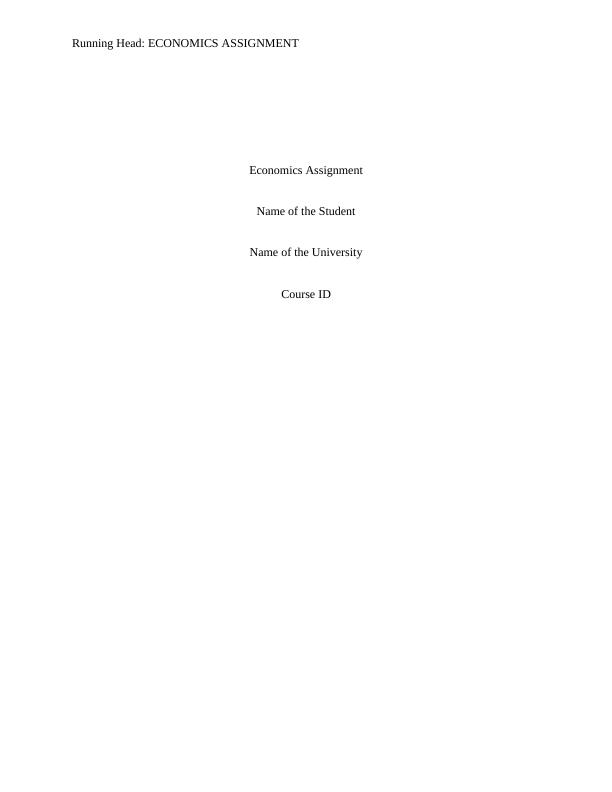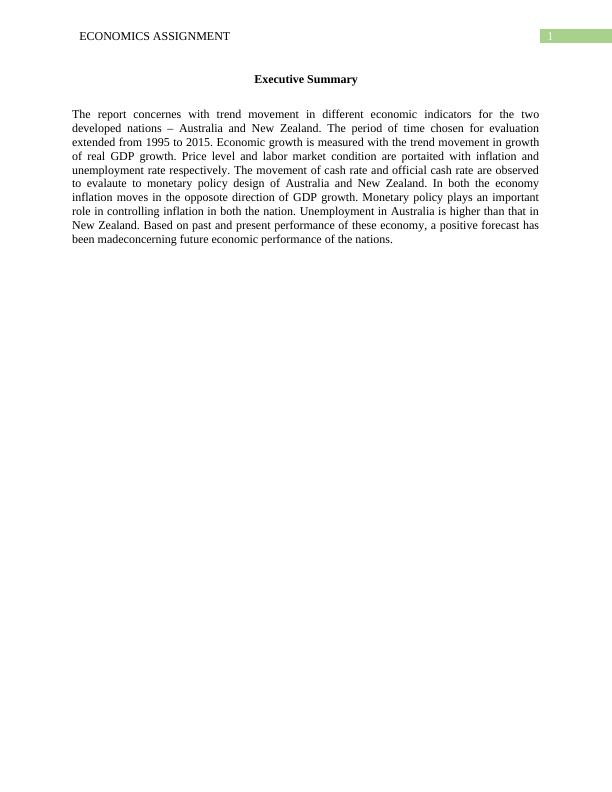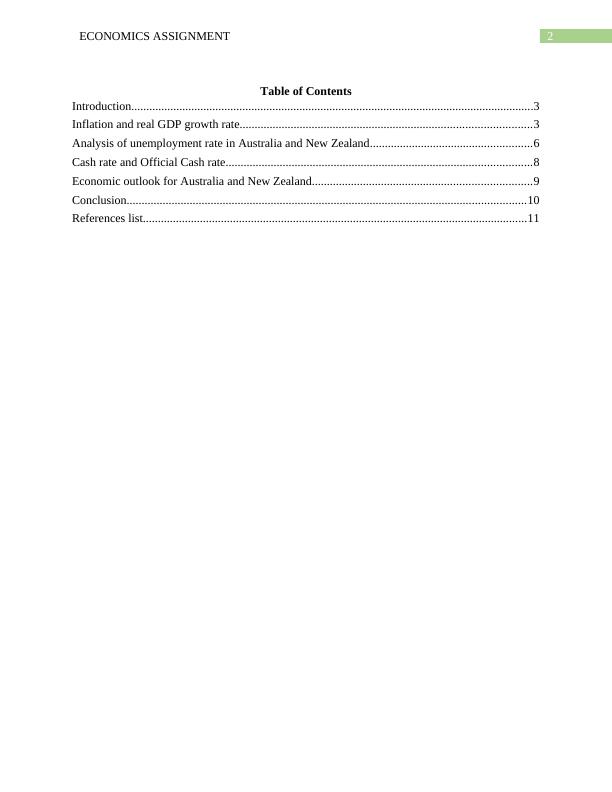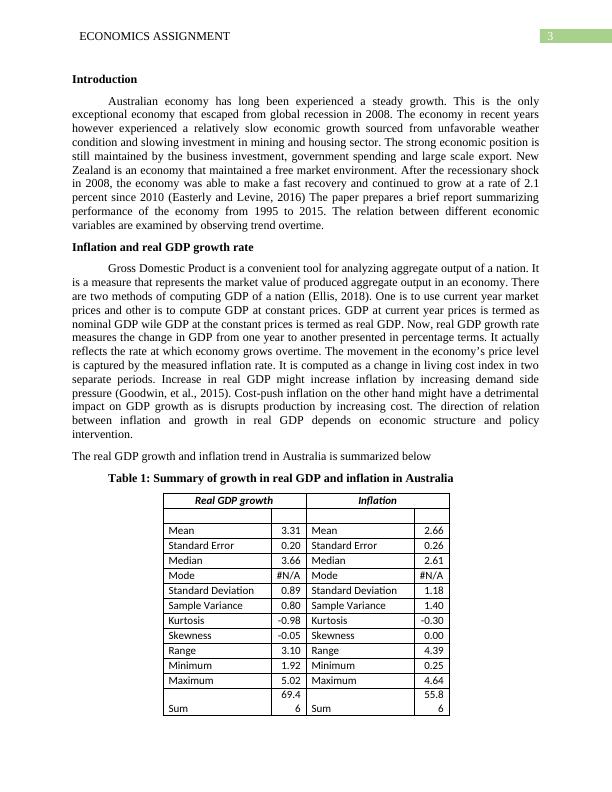Economics Assignment: Analysis of Economic Indicators for Australia and New Zealand
Added on 2023-06-08
13 Pages4241 Words413 Views
Running Head: ECONOMICS ASSIGNMENT
Economics Assignment
Name of the Student
Name of the University
Course ID
Economics Assignment
Name of the Student
Name of the University
Course ID

1ECONOMICS ASSIGNMENT
Executive Summary
The report concernes with trend movement in different economic indicators for the two
developed nations – Australia and New Zealand. The period of time chosen for evaluation
extended from 1995 to 2015. Economic growth is measured with the trend movement in growth
of real GDP growth. Price level and labor market condition are portaited with inflation and
unemployment rate respectively. The movement of cash rate and official cash rate are observed
to evalaute to monetary policy design of Australia and New Zealand. In both the economy
inflation moves in the opposote direction of GDP growth. Monetary policy plays an important
role in controlling inflation in both the nation. Unemployment in Australia is higher than that in
New Zealand. Based on past and present performance of these economy, a positive forecast has
been madeconcerning future economic performance of the nations.
Executive Summary
The report concernes with trend movement in different economic indicators for the two
developed nations – Australia and New Zealand. The period of time chosen for evaluation
extended from 1995 to 2015. Economic growth is measured with the trend movement in growth
of real GDP growth. Price level and labor market condition are portaited with inflation and
unemployment rate respectively. The movement of cash rate and official cash rate are observed
to evalaute to monetary policy design of Australia and New Zealand. In both the economy
inflation moves in the opposote direction of GDP growth. Monetary policy plays an important
role in controlling inflation in both the nation. Unemployment in Australia is higher than that in
New Zealand. Based on past and present performance of these economy, a positive forecast has
been madeconcerning future economic performance of the nations.

2ECONOMICS ASSIGNMENT
Table of Contents
Introduction......................................................................................................................................3
Inflation and real GDP growth rate.................................................................................................3
Analysis of unemployment rate in Australia and New Zealand......................................................6
Cash rate and Official Cash rate......................................................................................................8
Economic outlook for Australia and New Zealand.........................................................................9
Conclusion.....................................................................................................................................10
References list................................................................................................................................11
Table of Contents
Introduction......................................................................................................................................3
Inflation and real GDP growth rate.................................................................................................3
Analysis of unemployment rate in Australia and New Zealand......................................................6
Cash rate and Official Cash rate......................................................................................................8
Economic outlook for Australia and New Zealand.........................................................................9
Conclusion.....................................................................................................................................10
References list................................................................................................................................11

3ECONOMICS ASSIGNMENT
Introduction
Australian economy has long been experienced a steady growth. This is the only
exceptional economy that escaped from global recession in 2008. The economy in recent years
however experienced a relatively slow economic growth sourced from unfavorable weather
condition and slowing investment in mining and housing sector. The strong economic position is
still maintained by the business investment, government spending and large scale export. New
Zealand is an economy that maintained a free market environment. After the recessionary shock
in 2008, the economy was able to make a fast recovery and continued to grow at a rate of 2.1
percent since 2010 (Easterly and Levine, 2016) The paper prepares a brief report summarizing
performance of the economy from 1995 to 2015. The relation between different economic
variables are examined by observing trend overtime.
Inflation and real GDP growth rate
Gross Domestic Product is a convenient tool for analyzing aggregate output of a nation. It
is a measure that represents the market value of produced aggregate output in an economy. There
are two methods of computing GDP of a nation (Ellis, 2018). One is to use current year market
prices and other is to compute GDP at constant prices. GDP at current year prices is termed as
nominal GDP wile GDP at the constant prices is termed as real GDP. Now, real GDP growth rate
measures the change in GDP from one year to another presented in percentage terms. It actually
reflects the rate at which economy grows overtime. The movement in the economy’s price level
is captured by the measured inflation rate. It is computed as a change in living cost index in two
separate periods. Increase in real GDP might increase inflation by increasing demand side
pressure (Goodwin, et al., 2015). Cost-push inflation on the other hand might have a detrimental
impact on GDP growth as is disrupts production by increasing cost. The direction of relation
between inflation and growth in real GDP depends on economic structure and policy
intervention.
The real GDP growth and inflation trend in Australia is summarized below
Table 1: Summary of growth in real GDP and inflation in Australia
Real GDP growth Inflation
Mean 3.31 Mean 2.66
Standard Error 0.20 Standard Error 0.26
Median 3.66 Median 2.61
Mode #N/A Mode #N/A
Standard Deviation 0.89 Standard Deviation 1.18
Sample Variance 0.80 Sample Variance 1.40
Kurtosis -0.98 Kurtosis -0.30
Skewness -0.05 Skewness 0.00
Range 3.10 Range 4.39
Minimum 1.92 Minimum 0.25
Maximum 5.02 Maximum 4.64
Sum
69.4
6 Sum
55.8
6
Introduction
Australian economy has long been experienced a steady growth. This is the only
exceptional economy that escaped from global recession in 2008. The economy in recent years
however experienced a relatively slow economic growth sourced from unfavorable weather
condition and slowing investment in mining and housing sector. The strong economic position is
still maintained by the business investment, government spending and large scale export. New
Zealand is an economy that maintained a free market environment. After the recessionary shock
in 2008, the economy was able to make a fast recovery and continued to grow at a rate of 2.1
percent since 2010 (Easterly and Levine, 2016) The paper prepares a brief report summarizing
performance of the economy from 1995 to 2015. The relation between different economic
variables are examined by observing trend overtime.
Inflation and real GDP growth rate
Gross Domestic Product is a convenient tool for analyzing aggregate output of a nation. It
is a measure that represents the market value of produced aggregate output in an economy. There
are two methods of computing GDP of a nation (Ellis, 2018). One is to use current year market
prices and other is to compute GDP at constant prices. GDP at current year prices is termed as
nominal GDP wile GDP at the constant prices is termed as real GDP. Now, real GDP growth rate
measures the change in GDP from one year to another presented in percentage terms. It actually
reflects the rate at which economy grows overtime. The movement in the economy’s price level
is captured by the measured inflation rate. It is computed as a change in living cost index in two
separate periods. Increase in real GDP might increase inflation by increasing demand side
pressure (Goodwin, et al., 2015). Cost-push inflation on the other hand might have a detrimental
impact on GDP growth as is disrupts production by increasing cost. The direction of relation
between inflation and growth in real GDP depends on economic structure and policy
intervention.
The real GDP growth and inflation trend in Australia is summarized below
Table 1: Summary of growth in real GDP and inflation in Australia
Real GDP growth Inflation
Mean 3.31 Mean 2.66
Standard Error 0.20 Standard Error 0.26
Median 3.66 Median 2.61
Mode #N/A Mode #N/A
Standard Deviation 0.89 Standard Deviation 1.18
Sample Variance 0.80 Sample Variance 1.40
Kurtosis -0.98 Kurtosis -0.30
Skewness -0.05 Skewness 0.00
Range 3.10 Range 4.39
Minimum 1.92 Minimum 0.25
Maximum 5.02 Maximum 4.64
Sum
69.4
6 Sum
55.8
6

End of preview
Want to access all the pages? Upload your documents or become a member.
Related Documents
Business Economics: Economic Performance of Australia and New Zealandlg...
|14
|4165
|455
Macroeconomics Performance of Australialg...
|14
|4190
|34
Macroeconomic Performance of Australia from 1990 to 2016lg...
|13
|3611
|62
Economics Development - Solved Assignmentlg...
|14
|3546
|38
Global Economic Outlook for Upcoming Yearlg...
|14
|3494
|268
Australian economy and its relation with USAlg...
|11
|3532
|157
